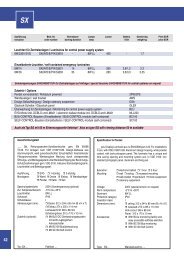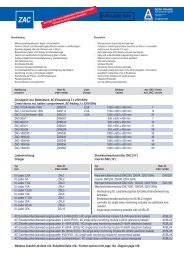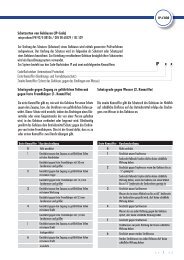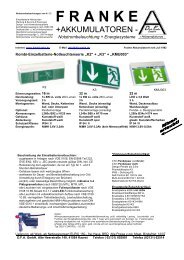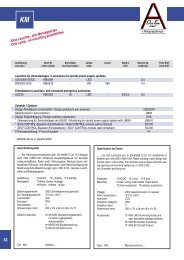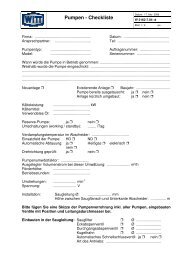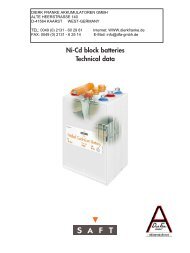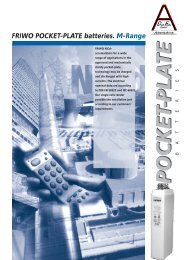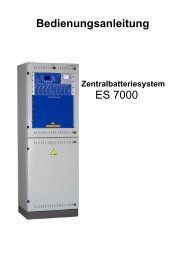Hochdruckschwimmer- Regler Montage- und ... - KomMa
Hochdruckschwimmer- Regler Montage- und ... - KomMa
Hochdruckschwimmer- Regler Montage- und ... - KomMa
Sie wollen auch ein ePaper? Erhöhen Sie die Reichweite Ihrer Titel.
YUMPU macht aus Druck-PDFs automatisch weboptimierte ePaper, die Google liebt.
Auch hier ist ein <strong>Hochdruckschwimmer</strong>-<strong>Regler</strong> zwischen<br />
Verflüssiger <strong>und</strong> Abscheider montiert, der das Kondensat<br />
auf den Mitteldruck entspannt. Ein zweiter <strong>Regler</strong> wird<br />
verwendet, um das Kältemittel zur Niederdruckseite zu<br />
entspannen. Zweistufige Kälteanlagen mit <strong>Hochdruckschwimmer</strong>-Regelung<br />
haben einen verbesserten Wirkungsgrad<br />
<strong>und</strong> vermeiden hohe Endtemperaturen der<br />
Verdichtung<br />
Da der zwischen MD- <strong>und</strong> ND-Seite montierte<br />
<strong>Hochdruckschwimmer</strong>-<strong>Regler</strong> das Kältemittel aus<br />
dem MD-Behälter bis zu seinem Abgriffspunkt zur<br />
ND-Seite ableitet, ist der ND-Behälter so auszuführen,<br />
dass die komplette schwankende Kältemittelmenge<br />
aufgenommen werden kann (ND-<br />
Seite <strong>und</strong> Überschuss der MD-Seite!).<br />
The system uses a float regulator between condenser<br />
and surge drum, this expands the liquid refrigerant to the<br />
intermediate pressure. A second regulator is used to<br />
expand the liquid refrigerant further to the low-pressure<br />
side of the system.<br />
Two stage refrigeration systems with float regulation<br />
have an improved efficiency and avoid very high gas<br />
temperatures for second stage compression.<br />
As all the liquid from the condenser and intermediate<br />
vessel up to the connection to the<br />
second float regulator is passed to the surge<br />
drum on the low pressure side, this has to be<br />
designed to accommodate the full amount of<br />
fluctuating refrigerant charge (low pressure side<br />
and excess of the intermediate side.<br />
5.1.3 Abtauen von Verdampfergruppen 5.1.3 Hot Gas Defrosting of evaporators<br />
Bei gängigen Abtauzeiten der Verdampfer (ca. 30 min)<br />
reicht für die Auslegung des <strong>Hochdruckschwimmer</strong>-<br />
<strong>Regler</strong>s eine 1,5 - 2 fache Leistung der gleichzeitig abtauenden<br />
Verdampfer aus. Sollten kürzere Abtauzeiten erforderlich<br />
sein, muss die Leistung auf das 3 – 4-fache der<br />
gleichzeitig abtauenden Verdampfer erhöht werden.<br />
For common defrost periods (ca. 30 min) the high side<br />
float regulator has to be sized for 1,5 - 2 times the capacity<br />
of the evaporators that are defrosted at the same<br />
time. If shorter defrost periods are required the capacity<br />
has to be increased up to 3 – 4 times the capacity of the<br />
evaporators that are defrosted at the same time.<br />
Die konventionelle Methode Verdampfer abzutauen ist in<br />
nachfolgender Zeichnung 7a beschrieben. Sie bietet sich<br />
an, wenn Verdampfer mit großen Leistungen eingesetzt<br />
werden.<br />
Dabei wird pro Verdampfer ein <strong>Hochdruckschwimmer</strong>-<br />
<strong>Regler</strong> vorgesehen, der das Kondensat in die Saugleitung<br />
zurückführt. Eine Standard-Unterdruckdüse reicht in der<br />
Regel aus, um ein Gaspolster zu verhindern.<br />
Ein hinter dem <strong>Regler</strong> montiertes Rückschlagventil verhindert<br />
ein Rückströmen von Kältemittel, wenn einzelne Verdampfer<br />
abgetaut werden.<br />
Diese Funktion kann auch von einem automatisch betätigbaren<br />
Ventil bzw. Kugelhahn übernommen werden.<br />
Wenn der Druck im Normalbetrieb den Öffnungsdruck des<br />
Rückschlagventils übersteigt (z.B. bei Einsatz von Verdampferdruckreglern),<br />
sollte auf jeden Fall ein automatisches<br />
Ventil/Kugelhahn eingesetzt werden.<br />
The conventional method of defrosting evaporators is<br />
shown in fig. 7a. This method is used particularly for<br />
evaporators with large capacities.<br />
There is one high side float regulator for each evaporator<br />
that drains condensate in the common pump return line.<br />
A standard low pressure nozzle is normally sufficient to<br />
avoid a gas buffer in the regulator housing.<br />
A check valve that is mounted behind the refulator will<br />
prevent a backflow of refrigerant when other evaporators<br />
are defrosted.<br />
For this function you may also use an automatic operated<br />
valve or ball valve.<br />
If the pressure during the normal refrigeration cycle can<br />
exceed the pressure that will open the check valve (e.g.<br />
when using back pressure regulators) you should always<br />
select an automatic operated valve instead of a check<br />
valve!<br />
Konventionelle Anordnung Fig. 7a Conventional defrost installtion<br />
24



